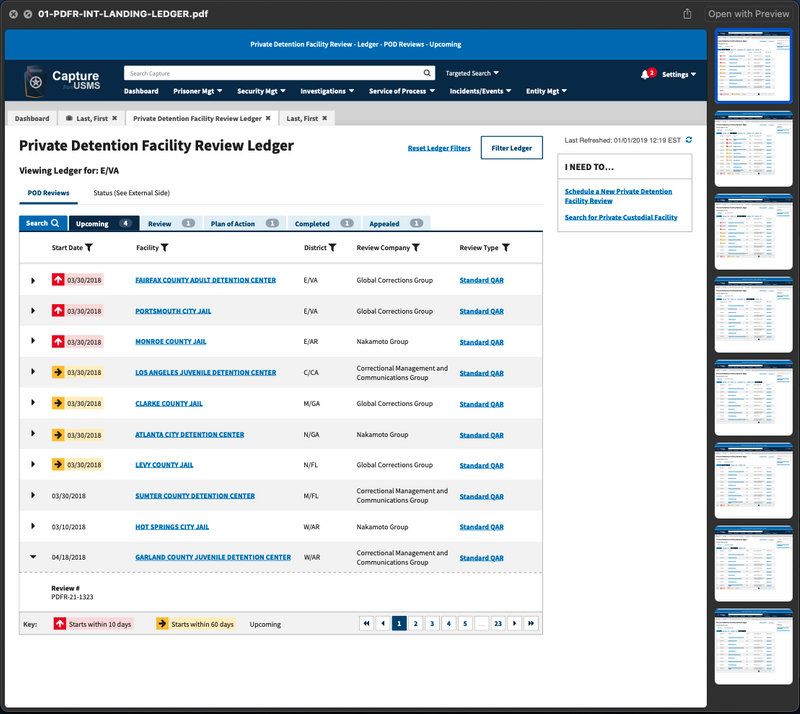UIUX working towards closing prisons [Archived]
UIUX for USDOJ
Problem Statement
In order for USDOJ to close a prison, the facility needs to be reviewed by internal and external auditors.
These audits contain 1000’s of questions that regularly change per policy basis.
As this process is currently Pen-and-Paper, it is unsustainable, meriting building this into USDOJ software.
These audits contain 1000’s of questions that regularly change per policy basis.
As this process is currently Pen-and-Paper, it is unsustainable, meriting building this into USDOJ software.
This work was completed via Accenture Fjord and Capgemini Government Solutions for USDOJ’s “Capture” Project, as part of USMS Intelligence Team.


United States uses lots of pen and paper tactics, making it very easy to throw away damning evidence at the highest level of judiciary operations.

This work created a digital process for reviewing “Private” Detention Facilities aka State owned (not Federally owned) Prisons that serve both state and federal needs.
This review process is particularly important to close down these max detention facilities.


Extended visual design for existing internal users to apply to new user class “External Reviewers”.


US uses static pages as its always under cyber attack, so some iterations solutioning for multiple users editing the same page include a Yield Icon + Smart Tag letting users know when others are editing.

Summary
Focus: Private Detention Facility Review
Create a piece of software that generates Internal and External Audits of USDOJ Detention Facilities
1. Working Style:
Together with subject matter experts, policy and functional analysts through multiple consulting style readouts.
2. Objective:
Update this previously abandoned UX deadzone using the previously defined visual design system.
3. Technical Challenge:
Update detention review forms while also including a new class of users, External.
Together with subject matter experts, policy and functional analysts through multiple consulting style readouts.
2. Objective:
Update this previously abandoned UX deadzone using the previously defined visual design system.
3. Technical Challenge:
Update detention review forms while also including a new class of users, External.
4. Existing Developer Constraints:
CMS is set up so each page is statically programmed by pixel which, while in accordance with USDOJ security policy, makes uploading 4000+ questions that change depending on policy quite significant efforts.
5. Implications:
Because of static pages + loading weights + cyber-security concerns, Internal and External users would not be able to see one another’s changes while simultaneously editing in the interface.
6. Strategic Value Delivered:
We turned development constraints as strengths and let the user know the implications outright and upfront via yield mark banner messages.
CMS is set up so each page is statically programmed by pixel which, while in accordance with USDOJ security policy, makes uploading 4000+ questions that change depending on policy quite significant efforts.
5. Implications:
Because of static pages + loading weights + cyber-security concerns, Internal and External users would not be able to see one another’s changes while simultaneously editing in the interface.
6. Strategic Value Delivered:
We turned development constraints as strengths and let the user know the implications outright and upfront via yield mark banner messages.
Retrospective
This job was a foundational character-building career chapter for me. It was another experience towards releasing the relationship between design-as-craft and pixel-perfect-implementation as a reflection of absolute success, particularly in the context of closing prisons.
The look of the work is often not as important as the work being implemented itself, particularly if the original design system is visually impaired and especially if it is on faulty production.
Neither the appetite nor expectation towards modern pixel-perfect UI even crossed these retired field agents' priorities.
Neither the appetite nor expectation towards modern pixel-perfect UI even crossed these retired field agents' priorities.
I am humbled by the fact that this contribution is only one part of an ongoing moving puzzle toward even a semblance or specter of closing prison, and that while the path forward might be murky, at least it is allegedly mapped out (legal follow-through still lies in the balance).
Conclusion
It is absolutely the right of States to try and buy time to prevent this should they choose to defend the status quo: case in point, Eric Adams buying lots of machine guns to allege for a “more tightly secure” Rikers Island. As absurd as the actual lack of reason that such a sentiment as this might have, such delays are commonplace.
Looking back on this, in a lot of ways, it is oftentimes is frustrating thinking about how much work is effectively just sitting on the shelf gathering dust. Detatching from the outcome always makes the most sense after offboarding, but I do hope that some such solution might one day be implemented, as there are lots of prisons I believe should be shut down.

*
